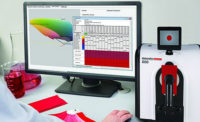Coordinate measuring machine (CMM) fixtures are an essential, yet frequently overlooked, part of quality control inspection. Companies generally tend to fixture their parts with whatever methods they deem fit, without regard to how those methods will impact inspection results. The CMM fixture system will not only secure a part for measuring, but will also have the greatest impact on gage repeatability and reproducibility (GR&R) results.
GR&R measures the amount of variability introduced by the measurement system. It is a statistical tool used to determine the variation introduced by the fixturing, the environment, the operators, the measurement program, the part variance, and the measuring instrument. Unfortunately when a GR&R shows variance, the fixturing method is usually the last factor checked.
On some materials, even those as strong as steel, the clamping force can cause a part to bend. Another concern is a component that is not secured and moves during inspection. Either case will be identified as operator variance in a GR&R since each part will not repeat in exactly the same way. Good design practices will counteract these issues and keep the fixture from exerting an influence on the part.
With this in mind, the following three considerations should be made when planning a fixture system:
1. What State Is It In?
Consider whether the component will be measured in a free (unrestrained) or restrained state based on the application. If possible, a part should be inspected in its free state to minimize any external factors. Every time an object is forced into a set condition, the amount of force or pressure used to fixture it influences measurement results. An item forced into a set position could skew the results and lead a company to believe it is making good parts when in reality it is not. Additionally, fixtures that fully restrain a component are generally more expensive and require calibration. If the datum change, expensive reworks and ongoing calibration of the fixture is needed.
Another concern with objects not inspected in their free state is the fact that they can be over-restrained. An over-restrained part is one that is restrained at multiple locations over six points. This creates the potential for the material to deform, especially for flexible components. Material that has been over restrained is more likely to flex during inspection, giving poor repeatability and bad data.
To alleviate the chance of over-restraining a part, fixtures must be designed to secure a part with minimal force. Any given component can move in 3-D space in six degrees of freedom (6DoF). These movements are those of translation—forward and back, up and down, left and right—as well as rotations around the axes (pitch, yaw and roll). The 6DoF must be arrested to ensure proper inspection results. Once these are secured, any additional clamps do not provide additional benefit.
To illustrate constraining, a part is placed on three points which are spread out to form a triangle that the center of gravity falls within. This restrains two degrees of rotation and one translation. Next, two points are constrained at 90 degrees to the three points, this will restrain one degree of rotation and one of translation (these need to be spread apart, ideally on a machined surface). Finally, one point at 90 degrees to the other points will control the last degree of translation.
The last consideration, when constraining a part, is clamping. Heavier parts may not need any clamping as gravity and friction is sufficient. In general, the force must be kept low and consistent. A good place to clamp is directly over the three points the part is sitting on. Poor selection of clamping positions is an easy way to bend the part. All these points are important to understand before any workholding is custom designed.
Inspecting an item in its free state is usually best for parts that are stronger and not easy to deform. There are, however, applications where measuring a part in a fully restrained state makes more sense. For instance, a part that will be attached to a stronger mating component might benefit from measurement in its assembled state. If two parts are to be attached, the interface between the two becomes a datum which pulls the part into a new shape. This new shape did not exist in the free state condition; it is caused when the part deforms to its mating component.
There are also times where, due to the machining processes, the component cannot be reasonably made in a free state. It might not be cost effective to engineer a good component when it will eventually assemble to its mating component. In this case, the most important consideration is that the completed assembly falls within specification.
2. How is the Fixture Designed?
Most companies are accustomed to the fixtures they use for machining operations. Some even make the mistake of designing their CMM fixtures in the same way as their machine tool fixtures. However the two types of fixtures are intrinsically different.
A machine tool fixture is designed to tightly grip a part during a manufacturing process, such as material removal. This fixture contains built-in datums, which are common reference points utilized by machine tools and CNC software programs. In contrast, a CMM fixture is used to hold a part during inspection, and does not contain reference points. The datums and features needed to inspect the part should be probed using the CMM to get optimum results. The only instance where a machine tool fixture makes sense is when the part must be deformed during inspection such as the case with mating parts. If this is required, the fixture must be accurate so it can correctly restrain the part onto its datum faces.
When a part is put into a fixture designed for a machine tool, it is locked into those datums. However, the fixture also contains its own measurement uncertainty which is a source for potential error. Essentially, the machine tool fixture itself has a tolerance which “steals” available tolerance from the part. On a CMM the part’s reference points are measured directly so only the uncertainty of the CMM is included. In essence, using inferred datums from a fixture just adds uncertainty to the measurement; ideally the fixture should just be ignored. From a GR&R perspective, this is important because the CMM can measure far more accurately than the part can be repeatedly loaded into a fixture.
Another concern with machine tool fixtures is the nature of the design. A machine tool fixture is sturdily built with a lot of material to grip the part during machining operations. A CMM fixture is designed to allow easy access to all relevant features. The forces involved in machining a part are higher, whereas a CMM applies a force of less than half a newton. The CMM fixture does not need to be strong, nor does it need to be particularly accurate. It is more important to hold a part’s angular orientations so the styli does not catch on the part while inspecting. In essence, the fixture only needs to hold the part still to allow access to the features.
3. What Are The Forces Involved?
A restrained part requires force to load it into its fixture. To ensure force is applied correctly, it is a good idea to start from the inside of the component and clamp outward. This deforms the part consistently and the force is pushed out to the ends, not back into the middle. A helpful analogy would be to think of getting bubbles out of wallpaper. To correctly eliminate the air, one must work from the center to the edges. Of course, depending on how the part is designed, a company may decide to implement special clamping based on the application. If there are multiple fixtures doing the same job, it is a good idea to measure their clamping forces so they may be standardized.
Small parts measured with an optical CMM have the advantage of not needing the clamping force that traditional tactile measurement needs. This is because an optical CMM is able to utilize noncontact technology to inspect parts. Smaller components are usually more fragile so care must be taken to not bend them in the fixture. It is more common to utilize custom fixtures on an optical or multisensor machine since flexible fixtures are usually adequate for parts over five millimeters in length. When using such a system, the fixtures need to be transparent and out of focus so they do not interfere with measurement results.
Fixturing is Key to Good Inspection Practice
Though often overlooked, CMM fixtures are essential to accurate inspection results. Rather than fixture parts haphazardly, a well-planned fixture system will improve GR&R results and eliminate a source of operator variance. Good design practices, even for flexible fixture configurations, eliminate undue influence on the part. By reevaluating fixtures based on the ideas contained within this article, or by consulting with industry experts, a company will avoid the undue cost and frustrations associated with repeated bad measurement results.






